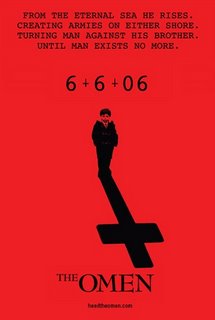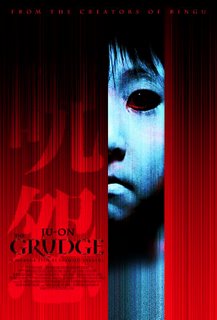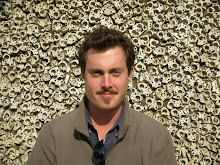 Not to jinx it so close to its finish, but we're almost through the Week of the Beast without the world ending, the rivers running red with blood, or cats and dogs playing together. No mass hysteria, no comets or plagues or anything like that. Phew, right? [Pause to wipe nervous sweat from agnostic brow.] What a relief.
Not to jinx it so close to its finish, but we're almost through the Week of the Beast without the world ending, the rivers running red with blood, or cats and dogs playing together. No mass hysteria, no comets or plagues or anything like that. Phew, right? [Pause to wipe nervous sweat from agnostic brow.] What a relief.Tuesday was officially the epicenter of the WotB, its date (if you're given to such flights of imagination and are wont to drop the occasional meddling zero) ringing hell's bells with its trifecta of gonghammer sixes. And, of course, Tuesday also marked the release of a new take on Richard Donner's* 1976 classic, The Omen. As marketing ploys go, it was an unmitigated success. As films go, let me put it this way:
 Had the world ended on Tuesday, had the Beast decided that now's a good time to run amok, twelve-million-dollars-worth of American moviegoers could count seeing the remake as a weight on their eternal souls.** Thank heaven (?) Satan is leaving all the destruction, terror, and mayhem to God these days. Beelzebub has realized it's best to stick with what he knows. He usually just does what comes naturally, laying low until the next Republican needs a slim margin in a major election.
Had the world ended on Tuesday, had the Beast decided that now's a good time to run amok, twelve-million-dollars-worth of American moviegoers could count seeing the remake as a weight on their eternal souls.** Thank heaven (?) Satan is leaving all the destruction, terror, and mayhem to God these days. Beelzebub has realized it's best to stick with what he knows. He usually just does what comes naturally, laying low until the next Republican needs a slim margin in a major election.But all that's sort of beside my point, which is this: isn't it strange how the newest thing in horror movies is creepy/haunted/undead/demonspawn children? We seem to have come full-circle from the time of the original Omen, passing through a wave of slasher flicks focused almost exclusively on teenagers and their value as hyperhormonal chainsaw fodder. What happened all of a sudden?
(Technically, the official first entry of this particular brand of horror flick would be Rosemary's Baby, Roman Polanski's 1968 chiller. That film featured Mia Farrow being impregnated by a hairy beast of a Beast in a truly ugly nightmare-rape sequence. Rosemary is the unwitting participant in the proceedings, her husband having sold the Friendly Local Coven a 9-month lease on her womb. See the flick to find out how it all ends, but watch it with the lights out. Really.)
Six years after Rosemary gave birth to Satan's lovechild, the slasher flick was already terrorizing America's teenage demographic. That was the year Tobe Hooper's The Texas Chainsaw Massacre gave rural Texas a REALLY bad name. A little later, in 1978, John Carpenter set deranged manchild Michael Myers*** loose on teenagers celebrating Halloween. Two years after that, Jason Voorhees terrorized Camp Crystal Lake (and Kevin Bacon) in Friday the 13th. And in 1984, Freddy Krueger planted his flag in the dreams of a generation (and Johnny Depp, for one more pop reference) in Wes Craven's A Nightmare On Elm Street. All of these movies spawned legions of imitators and countless sequels, but not until Scream signaled the slasher-flick's demise (by going totally po-mo on its ass, before ironically falling into the same dead-eyed cycle of rehashings it originally sent up****) did the new new thing in horror drift across the Pacific in a fog-shrouded ghost ship from Japan.
(Pardon that image. It's not accurate. It was actually a fog-shrouded FedEx jet that delivered prints to film festival screenings populated by really hip devil-worshiping zombies cloaked in torn black parkas. On skis. In Utah. Anyway...)
 With the rise of the Japanese horror (or J-horror) film in the mid-90's, Hollywood discovered that it was lagging sadly behind the curve of what people really think is scary. The slasher flick had grown bigger than its genre, to the extent that decapitations and dismemberments (ad infinitum) just weren't putting asses in the seats anymore. Into the vacuum rode J-horror movies like Ringu (remade in America as The Ring), Ju-On (The Grudge with Sarah Michelle Gellar), Kairo (this summer's upcoming Pulse), Gin Gwai (technically from Hong Kong via Thailand, but slated for a 2007 remake as The Eye), and Honogurai Mizu No Soko Kara (a mouthful, and the source of 2005's Dark Water). Instead of focusing on the exploits of a superhuman, undead/undying villain (a la Jason or Freddy), these films' "villains" are almost always ghosts seeking to right the wrongs done them in life. There are conclusions despite the evidence of sequels. These films were breaking box-office records overseas while setting the new standard for horror films on other shores. And, not surprisingly, Hollywood has been playing catch-up ever since.
With the rise of the Japanese horror (or J-horror) film in the mid-90's, Hollywood discovered that it was lagging sadly behind the curve of what people really think is scary. The slasher flick had grown bigger than its genre, to the extent that decapitations and dismemberments (ad infinitum) just weren't putting asses in the seats anymore. Into the vacuum rode J-horror movies like Ringu (remade in America as The Ring), Ju-On (The Grudge with Sarah Michelle Gellar), Kairo (this summer's upcoming Pulse), Gin Gwai (technically from Hong Kong via Thailand, but slated for a 2007 remake as The Eye), and Honogurai Mizu No Soko Kara (a mouthful, and the source of 2005's Dark Water). Instead of focusing on the exploits of a superhuman, undead/undying villain (a la Jason or Freddy), these films' "villains" are almost always ghosts seeking to right the wrongs done them in life. There are conclusions despite the evidence of sequels. These films were breaking box-office records overseas while setting the new standard for horror films on other shores. And, not surprisingly, Hollywood has been playing catch-up ever since.(A quick thought on foreign films in Hollywood: nobody would think about "re-envisioning" The Seventh Seal or 8 1/2 or The 400 Blows. That would be taboo, right? For chrissakes, Gus Van Sant was almost--deservedly--crucified for his shot-by-shot take on Hitchcock's Psycho, and that was a Hollywood flick to begin with. But for some reason Japanese cinema has given us a different rule when it comes to remakes. Akira Kurosawa's The Seven Samurai and The Hidden Fortress became The Magnificent Seven and Star Wars, respectively. And the kitana blade cuts both ways: after all, Kurosawa's Ran was an Asian appropriation of Shakespeare's King Lear. In the aforementioned J-horror case of Ju-On, the Japanese version's original director, Takashi Shimizu, was hired to helm the fucking-up of his own work for Japanese-owned Sony Pictures Entertainment. There's no mystery here, I guess, and I'm not calling for remakes of everything that comes across the A-pond out of some botched notion of equal time. I know that Cash Rules Everything Around the Hollywood Mainstream [CREAHM--get the money!*****], and nobody packs the house for an Austrian like Michael Haneke and his horrific excavations of the human psyche. I'm just saying.)
What each of these J-horror films has in common, besides any Asian origin, is that they all deal somehow with very young children as the perpetrators (or victims, but usually both in that case) of the horror.****** I won't go into any greater detail here, so as not to further bore all of you senseless with my reductive analyses of each film's storyline (get Netflix). Suffice it to say that the goings-on are supernatural in nature, taking the form of beyond-the-grave reprisals for the horrors visited upon children by the adults in the films. Young children represent a raising of stakes within the world of each film, an embodiment of vulnerability and dependence that, once betrayed, leads to otherworldly consequences. But instead of focusing on the exploits of a superhuman, undead/undying villain (a la Jason or Freddy), these films' "villains" are ghosts (and very young ghosts, too) seeking to right the wrongs done them in life. The element of mystery is key to J-horror, and the plotlines usually trace the unraveling of knotty circumstances surrounding the death of an innocent. That being said, and despite the evidence of sequels, the films conclude when the mystery is solved and some form of justice is meted out in the ghosts' names.
So there's a theory out there that every turn in the recent winding history of the horror movie serves as an onscreen portrayal of a society's most potent fears. The American horror flicks of the 1950's (check out Invasion of the Body Snatchers) were thinly veiled allegories of Cold-War paranoia, when even your neighbor (or his alien double) might be the guy who sells the Russkies the Bomb. Zombie movies (at least since George Romero's 1968 Night of the Living Dead) were thematically related, but on the other side of the divide. During the Vietnam-protest counterculture of the late 60's, the zombies were stand-ins for the military-industrial-political complex and every voter unhip enough to support it. Slasher flicks of the late 70's and 80's, which on the whole punished their victims for exploring their sexuality, reflected a strange, seemingly conservative expression of "sex equals death" in a bid for the post-sexual-revolution wallets of the wealthiest teenagers in America's history, the Baby Boomers' children. Later examples of the same genre (especially Craven's Nightmare and its sequels) can be read as early echoes of the AIDS crisis, when nobody knew if their wet dreams might cost them their lives.
The American horror flick experienced a brief denouement in terms of social relevance during the late 80's and early 90's, evidenced by trash like the Leprechaun series, Child's Play and its sequels, and latecomer goofs on Stephen King novels. Only recently has the genre revived itself, ushering in a new wave of American slasher flicks like Eli Roth's supercreepy Cabin Fever and Hostel, and recent big-budget remakes of The Texas Chainsaw Massacre (prequel coming this fall) and The Hills Have Eyes. These films owe a great debt to their predecessors in the slasher genre, but their human (if inbred, European, and inbred/deformed--in that order) villains separate them from the Asiatic herd. This American new wave--set apart in tone and content from the J-horror remakes that have flooded the American marketplace around them--are essentially revenge pictures, and have been interpreted as gory ruminations on post-9/11 America and our War on Terror. They are the cinematic expressions of "Let's roll," "Put a boot up their ass," "These colors don't run" and any such jingoism. A couple of them are also genuinely frightening.
 During American horror's stagnation, the Japanese were churning out the precursors to the J-horror flicks to come. The animated films of those years (especially Urotsukidoji [Legend of the Overfiend, 1989] and others like it)--while not quite horror flicks, per se--were not wholly, thematically different from American post-WWII horror flicks of sabotage and Commie infiltration. The Manga films showed the first genuine emergence of a fantastical post-nuke paranoia wandering through that country's popular imagination, forty years after Hiroshima and Nagasaki, and the forms that filmic paranoia took are astounding for the grandeur of their oddity. Just look at Urotsukidoji's promotional art [DVD cover pictured], at the mushroom-cloud of light on the Overfiend's chest as he prepares to devour an entire cityscape. Dominated by a famous scene featuring an army of fifty-foot sperm ransacking a hospital in search of impregnable human females, Urotsukidoji stands in testament to a nation and a people still reeling from the brink of nuclear annihilation, still dealing with the collective memory of millions scarred by radioactivity, fear, and loss. Until Russia (Ukraine now) releases anything similar twenty-plus years after Chernobyl, those Japanimation flicks will remain some of the scariest feats of human imagination in the wake of real, personal horror.
During American horror's stagnation, the Japanese were churning out the precursors to the J-horror flicks to come. The animated films of those years (especially Urotsukidoji [Legend of the Overfiend, 1989] and others like it)--while not quite horror flicks, per se--were not wholly, thematically different from American post-WWII horror flicks of sabotage and Commie infiltration. The Manga films showed the first genuine emergence of a fantastical post-nuke paranoia wandering through that country's popular imagination, forty years after Hiroshima and Nagasaki, and the forms that filmic paranoia took are astounding for the grandeur of their oddity. Just look at Urotsukidoji's promotional art [DVD cover pictured], at the mushroom-cloud of light on the Overfiend's chest as he prepares to devour an entire cityscape. Dominated by a famous scene featuring an army of fifty-foot sperm ransacking a hospital in search of impregnable human females, Urotsukidoji stands in testament to a nation and a people still reeling from the brink of nuclear annihilation, still dealing with the collective memory of millions scarred by radioactivity, fear, and loss. Until Russia (Ukraine now) releases anything similar twenty-plus years after Chernobyl, those Japanimation flicks will remain some of the scariest feats of human imagination in the wake of real, personal horror.So what of this new new wave, then, the J-horror flick? Whether or not (or until) they're bastardized by Hollywood, these films have acquired rabid followings, spawned numerous sequels, and show thematic similarities that can't be coincidental. The ghostly kids, the omnipresent water imagery, the spooky posthumous vengeance, et cetera. And what is it with the children again, all of a sudden? Thirty years after Donner's The Omen, its remake comes out (scripted by David Seltzer, the same man who wrote the original) on 6/6/06, following what have been bumper crops of J-horror remakes that have tilled similar (if not Satanic) territory. Is it simply a glitch of the marketplace, a déjà vu of sorts during which Hollywood attempts to cash in on shit that other folks are doing with more panache? You be the judge. If CREAHM ain't the reason, I sure as hell can't figure it out. Maybe this is globalization in action, and the Japanese are outsourcing their horror-flick ideas like we do helpline operators to Bangalore. It's a mystery at the moment, but perhaps one that will find its solution (and valid interpretations) around the corner. Until then, as long as they aren't serving it up raw (sushi horror?), the kids in Middle America are sure to eat it up.
*: Now that I think of it, Donner's having a bit of a rough summer. Along with the pointless remake already mentioned, his 1978 Superman is also getting a coat of polish (and maybe some manscaping) from Bryan Singer's Superman Returns. Next we know they'll be giving us a remake of Lethal Weapon--as if all three LW sequels, 16 Blocks (also Donner's), Training Day (sorta), Kiss Kiss Bang Bang ('cause gay is the new black?), Die Hards I, II: Die Harder, and With A Vengeance, and Rush Hour plus two sequels (one done, one upcoming--maybe Chinese is the new white?) hadn't already run the mismatched-buddy action-comedy into the fucking ground.
**: In the interest of full disclosure, I was $5.25 of it. BTW, it sucked devilnuts.
***: Not to be confused with Mike Myers, whose recent lack of funny is even more frightening. Lose the no-longer-hilarious Scottish accent, Mike, or I'm gonna forget both the original Wayne's World and the first Austin Powers. Don't test me, bitch. It's been a long week.
****: You know your franchise has jumped the shark when a spoof comes out to spoof your spoof. To wit: Scary Movie, which, not really coincidentally, just released its fourth installment. I'm not even sure how to itemize the ways that franchise has tripped over its own limited cleverness, but I'm pretty sure it has something to do with a Wayans brother. Or maybe a Sheen.
*****: Dollah dollah bill, y'all.
******: Kairo (Pulse) is the lone exception, since every rule needs one. Still, you get the point.
